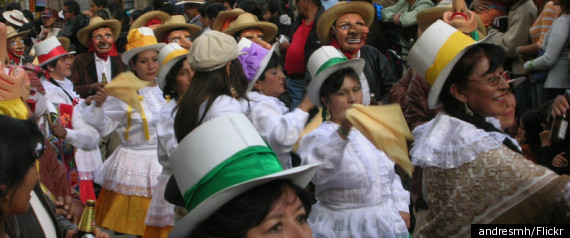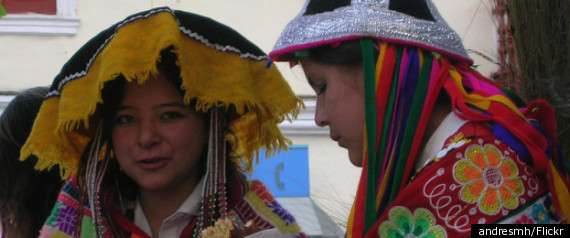I'm balancing a heavy plastic basket on my head. It's filled with pineapples, bananas, apples, oranges and other gifts I plan to present to Inti, the Incan God of the Sun. It's not exactly my offering. I was lucky enough to have been invited to this once-a-year-solstice ceremony by locals from Gualsaqui, Ecuador, a tiny village just up a treacherous road from Otavalo.
Along with five other gringos, volunteers with the US-based Tandana Foundation, I'm dancing, or rather stomping around in circles, with hundreds of indigenous party-goers.
Although thousands of gringos attend the theatrical representation of Inti Raymi near Cusco, Peru, each year, this is different. This is the real deal: a venerable religious ceremony complete with animal sacrifices and nine days of dancing and processions. Until recently, Inti Raymi has been completely underground thanks to the Catholic Church banning it in 1572 for being a pagan ceremony.
In other words, you pretty much have to know someone to get invited to the colorful event, which takes months of planning and costs thousands of dollars to prepare. Tourists would have as hard a time "getting in" to this particular Inti Raymi ritual as I would have had getting into Manhattan's Boom Boom Room.

We were given the nod because Natalie, Tandana's current intern, has been chatting up locals since February, providing regular medical assistance and volunteer teachers.
The colonial Spaniards who suppressed Inti Raymi for hundreds of years are getting their comeuppance in Gualsaqui as our Quechua hosts, dressed in all sorts of strange get-ups from furry chaps and military uniforms to gorilla costumes and giant cardboard hats painted black, are ceremoniously "taking back the plaza" from their usurpers.
Taking back what was rightfully theirs is a process. First comes the feast.
When we first arrived, after carefully unfolding ourselves from the back of a pickup where we'd been wedged with numerous friends and relatives of a nurse from Gualsaqui's Subcentro medical clinic, we were ushered into someone's backyard and plied with chicha, a straw-colored fermented beverage made from maize. I was happy to learn that one of the ingredients in traditional chicha, saliva mixed in by the person chewing the corn, had fallen out of favor. Chicha today is typically fermented in big plastic tubs, but drinking it still requires an intimacy to which we were unaccustomed.
The celebratory drink of chica is served communally in one small glass. Servers carry around a plastic bucket of the milkish liquid, present you with a glass of it and, to be polite, you chug it immediately so the glass will be available for the next person.
And we certainly don't want to be rude. Already, we'd missed the purification ritual (what sounded like communal skinny dipping in a sacred waterfall). Considering that most Quechua women normally wear long, two-layer anakos, the traditional costume and wouldn't dream of showing a shin, let alone a knee, this once-a-year sanctification was proof positive that this ritual is a special occasion.
After chicha, we were served plate after plate of rice, potatoes, what I believe was chicken, more rice and potatoes and soup, all prepared in well-seasoned hula hoop-sized pots over a blazing outdoor fire. Of course, a great portion of the vittles were reserved for our eventual presentation to the great Sun God.
In addition to the baskets of fruit we're carrying on our heads, we're dancing with a giant homemade cross covered with flowers, a woven platform with even more fruit, bread, chips, boxes of orange drink and money and a long stick tied with live chickens, bottles of sprite and a rooster with a five-dollar bill piercing his beak.

Once our parade entry has finally assembled, we begin to stomp/dance towards the plaza which, in Gualsaqui, is actually a soccer field. A big stage has been set up where representatives receive gifts designed to please Mother Nature. The stomping, we are told by the Aya Uma -- the costumed guy chosen to represent the Aya Uma (aka the spirit of the mountain) -- is to invite Mother Earth to participate in the party.
I don't know how she could miss us. We are stomping in circles in front of every house in the village, accompanied by a guitar, a pan flute, a violin and a drum. Finally, three hours later, we take our turn at the grandstand.
With much fanfare, the officials graciously accept our donation and assure us that next year will be fruitful. Here's hoping.